The goal of this paper is to provide an actual evidence base to confirm or dispel anecdotal belief among experienced paramedic faculty that paramedic professional education paralleled or exceeded the professional education of associate degree registered nurses, which seems to be the generally accepted understanding of the general public, the healthcare community, and even practising paramedics.
This research follows up on earlier published peer-reviewed research comparing paramedic and nursing professional education in the Northeast United States, where the author found that at 23 colleges in the Northeast United States that had both paramedic and registered nursing education programmes offered for college credit, paramedic professional education required a mean of 41 credits compared to a mean of 37 credits for nursing professional education. (Phelps, 2015). This paper extends that research to all US 2-year colleges with accredited paramedic and nursing programmes. This research is important, because if paramedics and nurses have equivalent professional education, then the current status of paramedics as a subordinate profession to nursing (in many states and settings) may not be valid and occupational boundaries for each profession may need to be redefined.
Background
Both paramedics and registered nurses may be educated through certificate/diploma programmes, through associate degree programmes, and through bachelor degree programmes, with each degree providing a pathway to virtually identical professional licensure as a paramedic or registered nurse, respectively. For paramedics, only Texas makes a distinction between degree versus certificate/diploma paramedics, but the distinction is one of licensure—clinical care is identical. Oregon requires paramedics to have an associate degree, while Arkansas has no accredited certificate/diploma programmes in the state (CAAHEP, 2004; Arkansas Department of Health, 2011; State of Oregon Administrative Rules 265 §333-265-0025.3f; Texas Administrative Code 25.1.157.C §157.40). Likewise, although there is is a strong push towards bachelor-level education for for registered nurses, it is not yet a requirement for licensure and certificate/diploma, associate degree, and bachelor's degree nursing programmes all lead to identical licensure as a registered nurse (American Association of Colleges of Nursing, 2000).
However, the breakdown of certificate/diploma programmes versus associate degrees versus bachelor's degrees between the two professions shows a marked difference, with nursing shifting their registered nurse professional education paradigm toward degree programmes and away from certificate/diploma programmes over the past 30 years, while paramedic professional education still skewed heavily towards the certificate/diploma until relatively recently (Figure 1), when National Registry of Emergency Medical Technician requirements have driven paramedic education into a degree structure, with a 400% increase in associate degree programmes and a 100% increase in bachelor's degree programmes over the past 10 years (CAAHEP, 2004; American Association of Colleges of Nursing, 2011; Federal Interagency Committee on Emergency Medical Services, 2011; National League for Nursing, 2013)
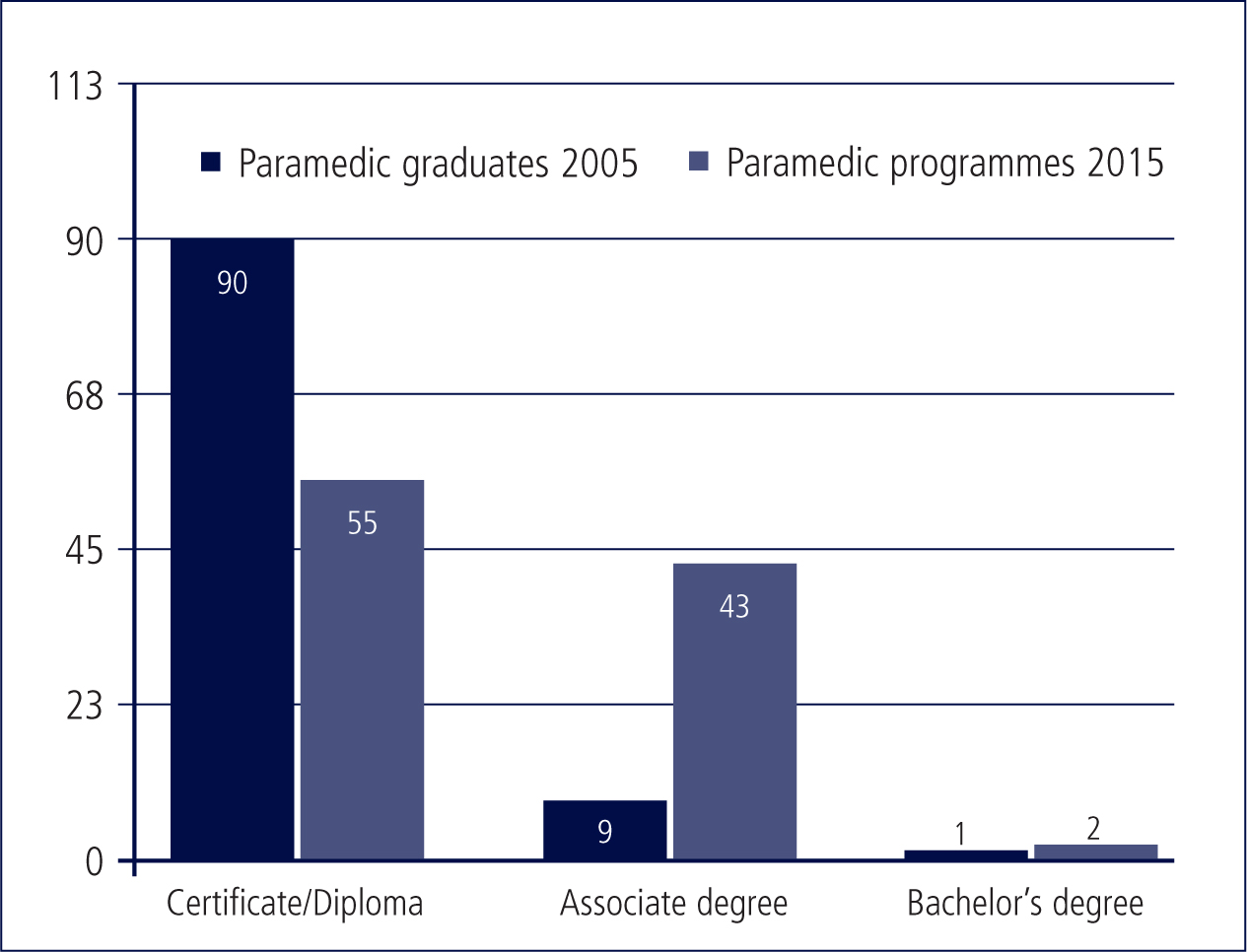
Paramedic professional education today is roughly analogous to nursing professional education in 1980, when 55% of registered nurses held a certificate/diploma (Health Resources and Services Administration, 2010; Federal Interagency Committee on Emergency Medical Services, 2011). For many paramedics, there has traditionally been limited opportunities to earn an associate degree in paramedic care (only 9% of paramedics held an associate degree in paramedic care in 2005 versus 43% of paramedic programmes offered as an associate degree in 2015) and virtually no opportunity to earn a bachelor's degree in paramedic care (bachelor's degree programmes still consist of 13 programmes nationwide, fewer than 2% of all paramedic programmes) (CAAHEP, 2004; Federal Interagency Committee on Emergency Medical Services, 2011, 2011). However, almost a quarter of paramedics do continue to the bachelor's-level (23% of paramedic who hold this degree), just not in paramedic care (Figure 2) (National Registry of Emergency Medical Technicians, 2014).
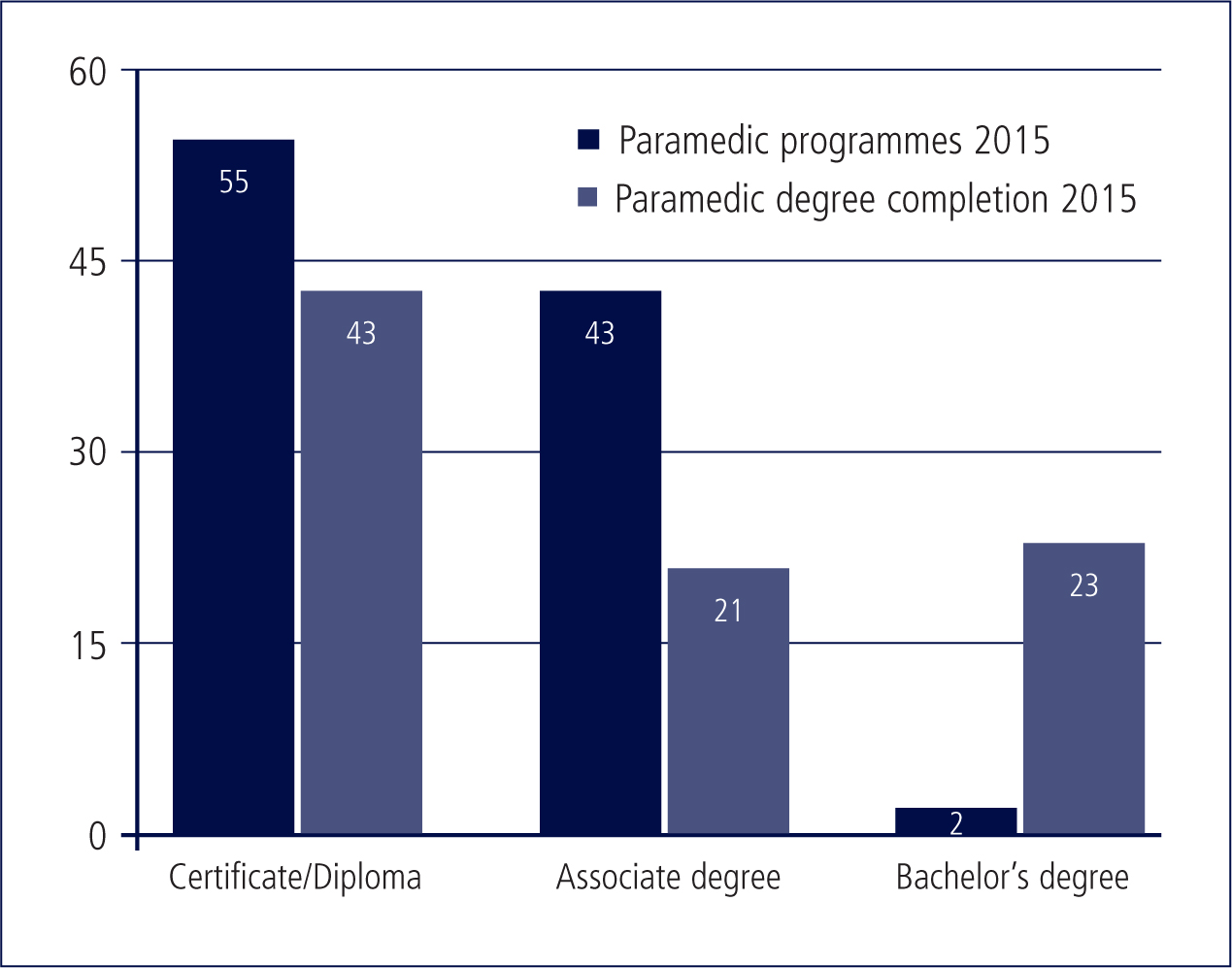
In contrast, in 2008 13.9% of registered nurses held a non-degree certificate/diploma, although only 4% of all registered nurse education programmes remain certificate/diploma programmes; 36.1% held an associate degree, although 58% of registered nurse education programmes are now associate degree programmes; and 36.8% held a bachelor's degree, although 38% of all registered nurse education programs are bachelor's degree programmes (Figure 3) (American Association of Colleges of Nursing, 2004; National League for Nursing, 2013).
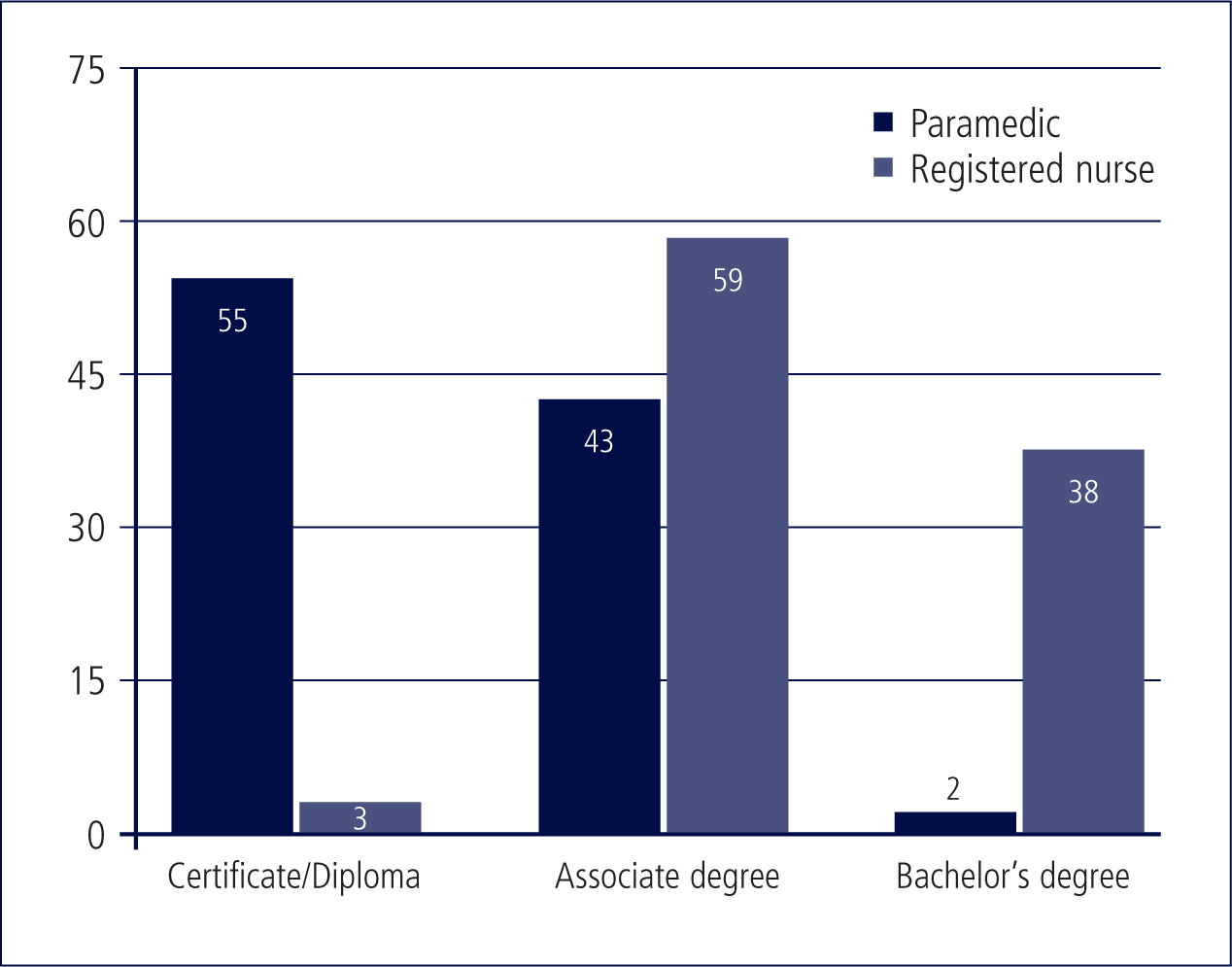
Within nursing, there is an obvious generational lag between registered nurse education programmes versus the actual education of working nurses—within one generation, registered nurse professional education has dramatically shifted away from certificate/diploma programmes (Figures 4 and 5).
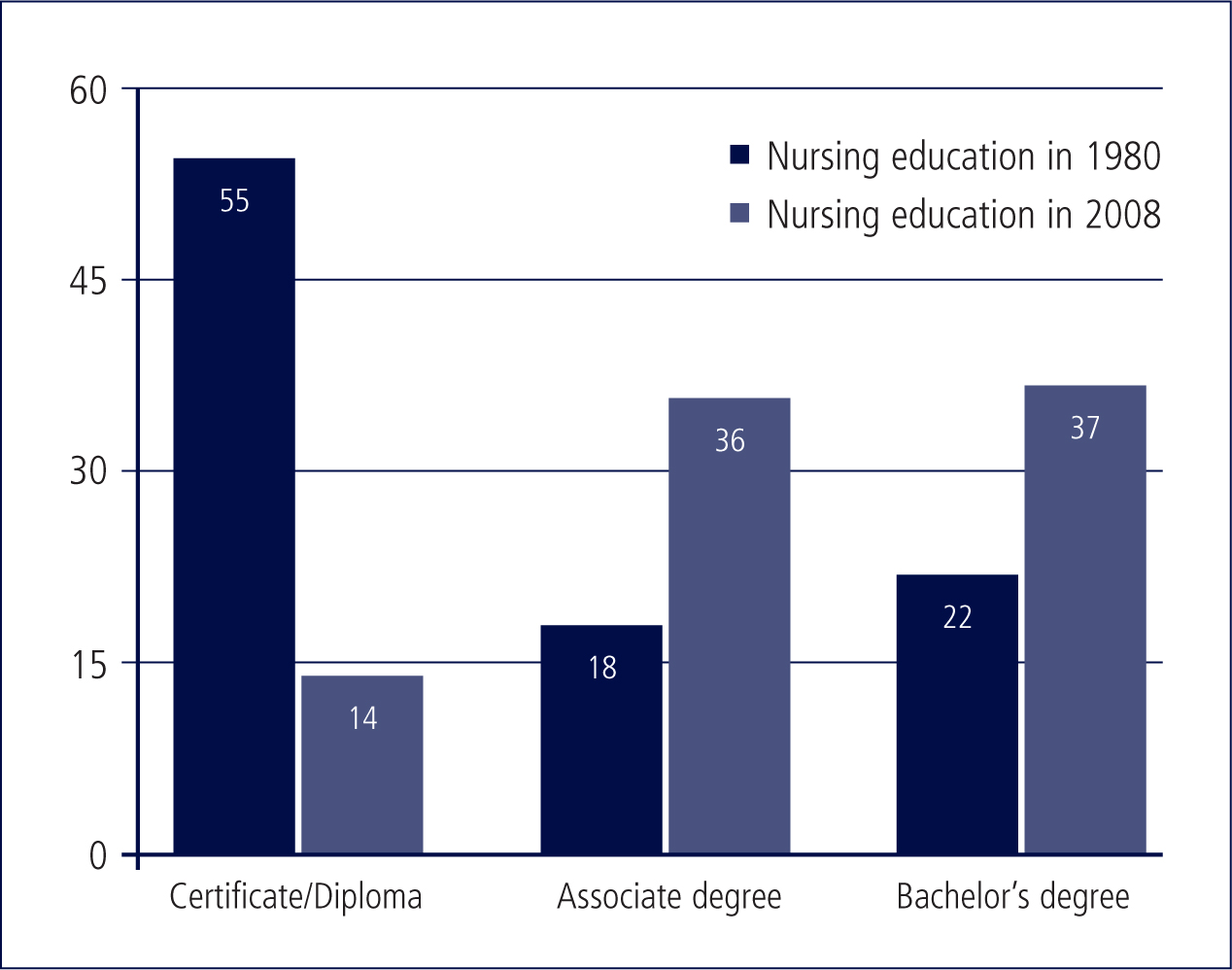
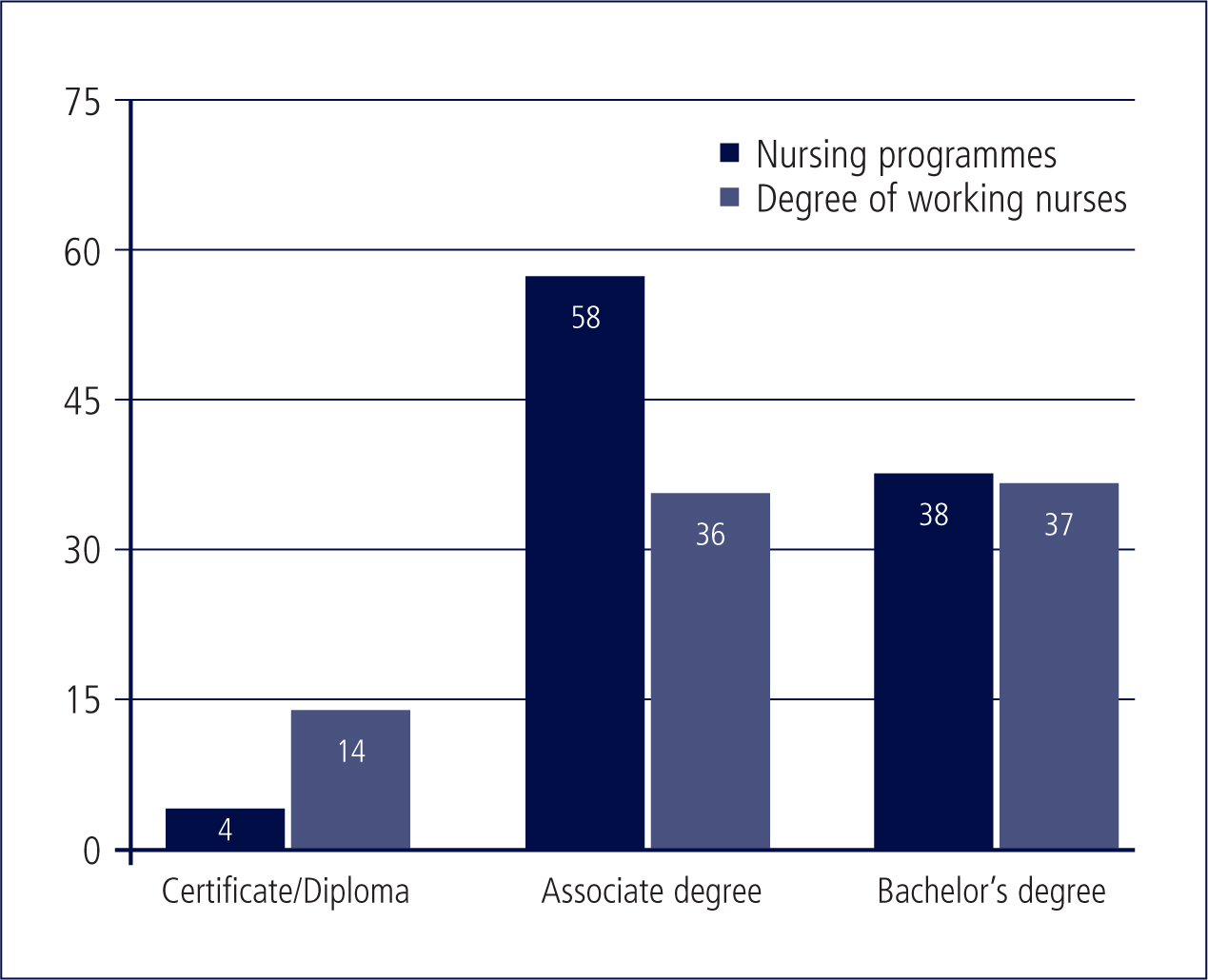
This difference between paramedic and registered nursing degree completion may be caused by any number of reasons beyond the scope of this paper: number and availability of programmes offered, incentives to complete a degree, increase (or lack thereof) in earnings from degree completion, and tuition reimbursement may all be causes, or it may be an artifact resulting from the fact that paramedics are a smaller, more diffuse, and younger profession than nursing (National Highway Traffic Safety Administration, 2008; Health Resources and Services Administration, 2010; Federal Interagency Committee on Emergency Medical Services, 2012). That said, with three different degree entry points for both, coupled with gradual shifts toward degree-based education in both professions, the goal of this research was to compare the amount of professional education of paramedics compared to the professional education of registered nurses, rather than non-clinical degree requirements, which are inherent in a shifting degree environment.
In both professions, there is a high degree of consistency in professional education. 48 out of 50 states (all but Kansas and Michigan) utilise the US Department of Transportation National Standard Paramedic Curriculum. In addition, 45 states either require or permit use of the National Registry of Emergency Medical Technicians (NREMT) paramedic certification exam as their state licensure, which as of 2013, requires that all paramedic exam candidates have graduated from education programmes that are either accredited or are seeking accreditation by the CAAHEP (National Registry of Emergency Medical Technicians, 2011; CAAHEP, 2004). All registered nurses in the United States, no matter what their professional education programme, take the same National Council Licensure Examination (American Association of Colleges of Nursing, 2011).
Methods
Because 48 states (Oregon is the exception by law and Arkansas by practice) only require paramedics to complete a certificate/diploma education programme in order to test for paramedic licensure, while every state requires associate degree registered nurse candidates to successfully complete their degree programme, we first looked to identify CAAHEP-accredited paramedic programmes taught for college credit at community colleges (whether it was a degree or a certificate/diploma programme). We then compared them to registered nursing programmes at the the same institution to see how, in the same setting and using the same metric for credit assessment, colleges viewed the professional education programme of both professions (CAAHEP, 2004; Arkansas Department of Health, 2011; State of Oregon Administrative Rules 265 §333-265-0025.3f; Texas Administrative Code 25.1.157.C §157.40). The website of each educational institution on this list was reviewed to find institutions that offered college credit (although not necessarily a degree) for their paramedic educattion programme and that had an associate degree nursing programme as well.
A total of 259 comparison pairs were identified where American colleges with a CAAHEP-accredited paramedic programme taught for credit also had an associate degree registered nurse programme.
Curricula were reviewed, and all mandatory courses listed under nursing or paramedic department label were included (e.g. NUR 101, EMS 101). While biology, anatomy and physiology were almost always co-requisites for both professions, they were often not taught by the nursing or paramedic departments, so were not included. If emergency medical technician (EMT) was pre-requisite to the paramedic programme and/or nursing assistant was a pre-requisite to the nursing programme, and the college offered the class for credit, that number was included. If it was a pre-requisite, but college did not offer for credit, it was not included.
| Paramedic education | Nursing education | |
|---|---|---|
| Mean # college credits | 49.32 | 41.75 |
| Median # college credits | 48 | 40 |
| Mode # college credits | 53 | 42 |
| Range | 24–87 | 27–77 |
| Variance of college credits granted | Where paramedic > nursing (81%), range 1–33, average 10.73 college credits | Where nursing >paramedic (17%), range 1–38, average 6.56 college credits |
| Variance of aggregate credit differences | 91.73 | |
| Standard deviation of aggregate credit differences | 9.58 | |
Results
Paramedic professional education programmes ranged from 24–87 college credits, with a mean (average) of 49.32, a median (half above, half below) of 48, and modes (most frequent number) of 53 college credits, while registered nursing professional education programmes ranged from 27–77 college credits, with a mean (average) of 41.75, a median (half above, half below) of 40, and a mode (most frequent number) of 42 college credits. In 209 of the 259 pairs (81%), the paramedic professional education was granted more college credits (range: 1–33 credits, average of 10.73 credits), paramedic and registered nursing professional education was granted an equal number of credits at 7 colleges (2%), while registered nursing professional education was granted more credits (range: 1–38 credits, average of 6.56 credits) than paramedic professional education at 43 (17%) of the colleges. The variance in credit between paired programmes is not a normal distribution and skews to the right (Figures 6 and 7).
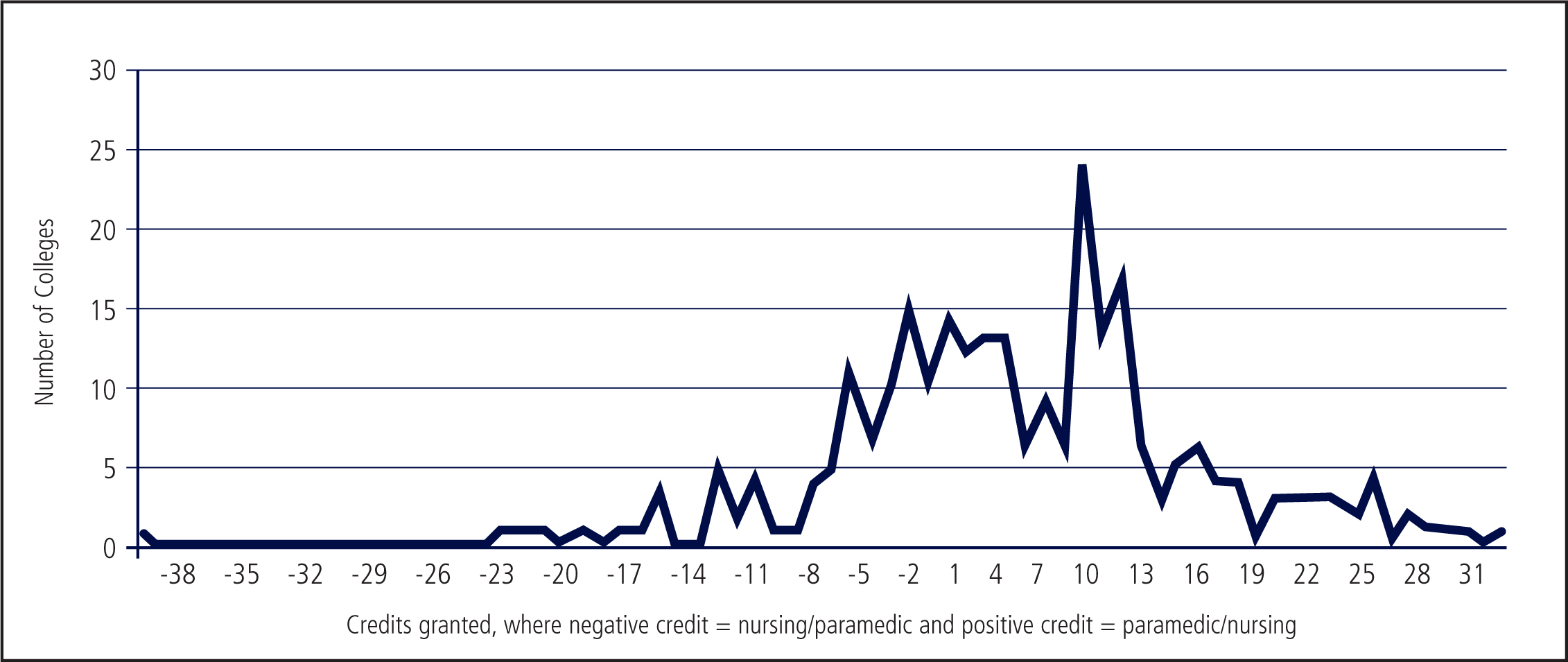
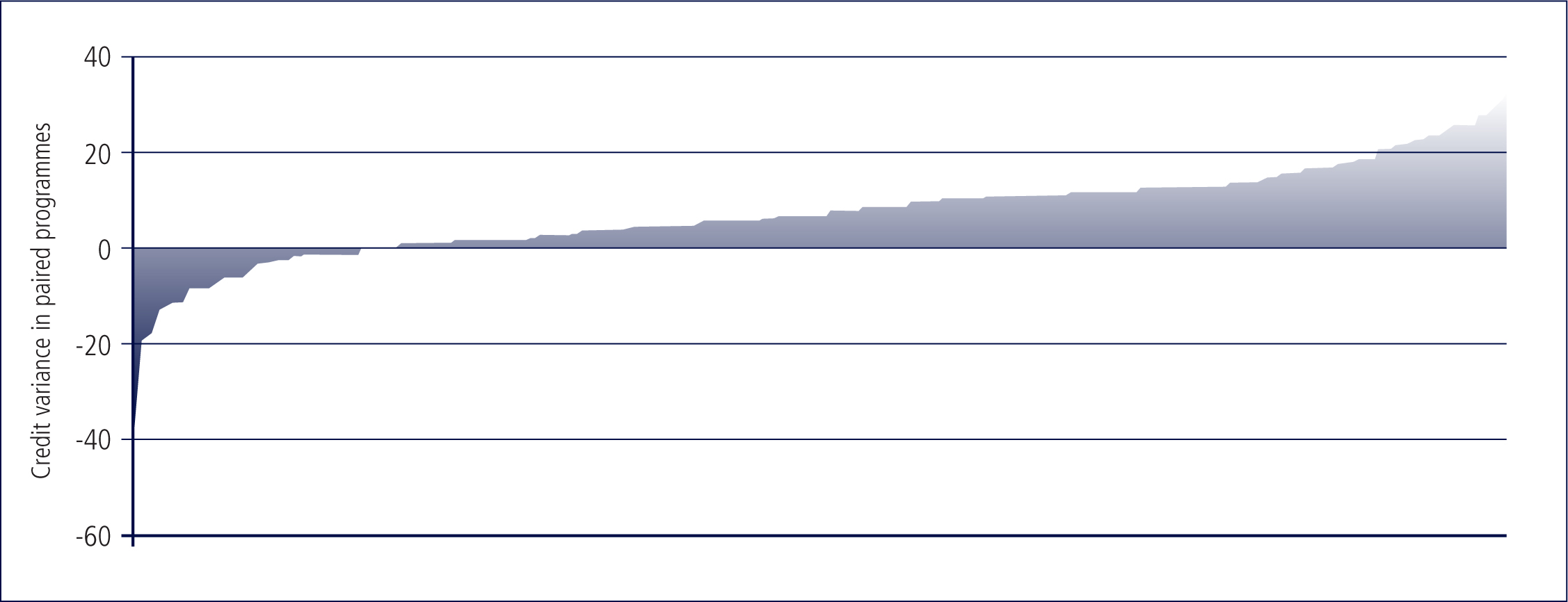
Discussion
Paramedics and registered nurses have countless interactions each day, and as a rule, respect each other's knowledge and skills. But conflict is inevitable as registered nurses cross over into the pre-hospital emergency care setting and paramedics expand into community paramedicine and emergency department roles. Much of this conflict centres on who is more qualified and thus raises of question of who should be in charge? As recently as 2015, a representative of The Texas Emergency Nurses Association stated that ‘The focus of the (paramedic) training is on skills,’ and implied that paramedics are ‘less qualified providers’ (The Unwired Medic, 2015). The representative added: ‘This bill (will) encourage hospitals to utilise less qualified providers for staffing’ and implied that registered nurses have more professional education than paramedics as the registered nurse has ‘extensive preparation in pathophysiology, pharmacology, skills, and critical thinking/clinical judgement’ (The Unwired Medic, 2015). This perceived status, where paramedics are held to have less professional education than registered nurses is reinforced by state regulation: many state boards of nursing and nursing associations have interpreted their nursing practice act to require that registered nurses supervise paramedics in states where paramedics are permitted to work in a hospital emergency department, yet no states explicitly require paramedics to supervise non-paramedic registered nurses when they work in the pre-hospital emergency care setting on an ambulance or helicopter (Massachusetts Nurses Association, 2003; Minnesota Nurses Association, 2005; Kentucky Board of Nursing, 2014). This is despite the National EMS Scope of Practice holding that ‘The paramedic is the minimum licensure level for patients requiring the full range of advanced out-of-hospital care’ (National Highway Safety Traffic Administration, 2007).
In fact, the Air and Surface Transport Nurses Association objects to registered nurses working in the pre-hospital environment being subject to any non-nursing oversight at all, holding that ‘Transport nursing is a specialty within the scope of nursing practice’ (Air and Surface Transport Nurses Association, 2010). This ‘technician’ language is also pervasive in public discussions of paramedics—one publication noted that, ‘Paramedics fall between EMTs and nurses in terms of medical training’ (Keegan, 2012).
According to 2011 research, the public has no concrete idea how much education paramedics have, but thinks emergency medical technicians should have some college and paramedics should have an associate degree (Gibson and Bentley, 2011). Perception drives policy, and this ‘positive feedback loop’ where perception drives regulation, and regulation drives perception, has meant that paramedics are perceived to be subordinate to registered nurses and that regulation mandates that subordinate status, regardless of the actual facts. We expect this data may come as a surprise to many paramedics, who may have assumed that both perception and regulation must be correct.
The results of this study undermine the contention that registered nurses have more professional education than paramedics. In fact, the opposite is true. even without a degree requirement, paramedics have more professional education than associate degree-registered nurses both at the individual institution level (81% of the time) and at the aggregate national level, with the median (48 versus 40 college credits) of paramedic professional education significantly exceeded registered nursing professional education. These results indicate that paramedics are required to have more professional education than registered nurses are at the point of licensure, and establishes that paramedics are not a subordinate profession to nursing. These results should trigger the ending of barriers to full professional practice by paramedics—there is no educational justification for mandating nurse staffing of pre-hospital or interfaculty transfer vehicles, mandating nurse supervision of paramedic practice in any setting, or barring paramedics from emergency medical practice in any setting. All regulatory barriers to practice, such as New Jersey's prohibition of staffing specialty care transport units with paramedics and mandating registered nurses, should end immediately (New Jersey Administrative Code §8:41-10.8).
With the differences in entry level professional education favouring paramedics, perhaps registered nurses are getting continuing education on the job. They do (and many registered nurses do go back for more advanced degrees in nursing), but even there a disparity remains in the minimum professional education requirements, with 15 states having no continuing education requirement for registered nurses and no state requiring registered nurses to complete more than 20 hours of professional continuing education a year. At the same time, more than 80% of states require paramedics to complete more than 20 hours of continuing professional education annually. (Table 2) (Federal Interagency Committee on Emergency Medical Services, 2012; American Nurses Credentialing Center, 2014).
| Hours of annual continuing education required | No requirement | 1–20 hours | 21–40 hours | >40 hours |
|---|---|---|---|---|
| Paramedic | 3 | 2 | 20 | 23 |
| Registered nurse | 15 | 36 | 0 | 0 |
Conclusions
At 259 paired paramedic: registered nurse programmes at community colleges in the United States, colleges granted paramedic professional education more college credit than registered nurse professional education at the individual college level 81% of the time. At the national level, the median of paramedic professional education exceeded registered nurse professional education by 20%. Even after licensure, paramedic professional education continues to exceed registered nursing professional education requirements, with 80% of states requiring paramedics to complete more than 20 hours of annual continuing education, compared to no state requiring registered nurses to complete more than 20 hours of annual continuing education.
These results indicate that in the United States, paramedics are not a subordinate profession to nursing and should trigger the ending of nurse staffing mandates in the pre-hospital and transfer setting, ending limitations on paramedic practice, and ending mandates which place paramedics in a subordinate status to registered nurses.
Further research comparing paramedic and nursing education in other countries is necessary to see if results can be extended more generally to other nations with similar pre-hospital models of care.
Key Points
Conflict of interest: none declared
